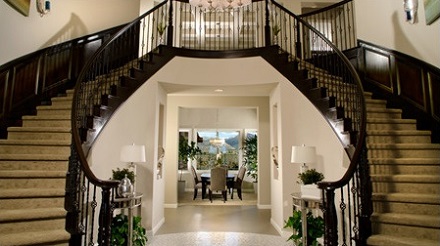
Home Builder | Homebuyers who want the space and spaciousness of a two-story residence need to know a thing or two about stairs and staircases.
That’s because every two-story home naturally needs at least one full staircase to allow access between the floors.
Some 305,000 of the 569,000 new detached houses builders completed in 2013 had two or more stories and 166,000 had a full or partial basement, according to the U.S. Census Bureau. That suggests builders constructed something like 471,000 or more staircases during that one-year timeframe.
Like doughnuts, staircases come in two types: fancy and plain.
Which type is built in a particular home depends primarily on the price range, with fancy staircases being more expensive than plain ones, explains Julie Hauge, sales manager at Drees Homes, which builds homes in Cincinnati; Dallas; Raleigh, N.C.; Jacksonville, Fla.; Washington, D.C., and other cities.
“In our entry-level products, you won’t have the big spiral staircase with all the wrought iron that’s a showpiece when you open the front door. We do offer that on other homes as you escalate in size and price,” Hauge says.
Fancy Staircases
A grand staircase is one of the few opportunities in a new home's design for the architect to have fun and truly define the character of the home and its occupants, says Erik Koss, president of Koss Design + Build in Phoenix, Ariz.
A dining room or bedroom is always about just four walls, but a staircase can be “an important piece and major design element in a house,” Koss says.
While a basic staircase might have a fairly standard-sized step, a nicer one might have a circular shape and a customized step size. Six inches high and 12 inches deep is fairly standard, though Koss says most people prefer a stair that’s a bit lower and deeper.
“If they can make that 6 inches 5 or 4.5 and make that 12 inches 13 or 14 inches, they like that better. The steeper the stair, the hard it is (to climb),” he says.
Go Natural
Along with its size and shape, a staircase’s building materials can also make a huge difference between a plain staircase and one that’s decidedly upscale.
Koss says he favors high-quality natural materials like any type of hardwood or any type of real stone for a staircase that’s both beautiful and low-maintenance.
“That will be more costly, but if you’re doing a statement piece, you want something that will last and stand the test of time,” he says.
Plain Staircases
Plain staircases are utilitarian affairs often built out of sight, rather than at the home’s front entrance. “It’s a staircase that has to go where it has to go, whether it’s in the back of the house or to the basement or into a utility room and it’s very mundane,” Koss says.
A plain staircase doesn’t have to be a straight run of 30 steps from one floor to the next, says Trey Bitteker, general sales manager for the Arizona division at Pulte Homes. “Instead of a long staircase, which takes up a lot of room, we do a shorter one,” Bitteker says. “It’s five steps up, then you make a left on a small landing, then go left again and up another five steps. You break it up. You can also put a nice big-sized window where you make the turn to open it up and let in some natural light.”
One way to keep the cost of a staircase modest is to use laminates or carpet on the stairs. Koss says those materials aren’t as durable as hardwood or stone, however, and will have to be replaced more often over time due to normal wear.
Choosing a Staircase
Whether a big spiral staircase is right for you might depend on whether you love large open spaces, Hauge says. “(Home owners) want that feeling,” she says. “It’s all about what you see when you open the front door.”
A desirable staircase can be a plus when you sell your home as well, Koss suggests, since other buyers might want that open spacious feeling as well.
Up or Down
Some houses also have outside staircases that lead up from the street level to the entrance or up above the house to a garden, swimming pool or other outdoor area.
For outdoor stairs, Koss likes to emulate the design of the house or the landscaping and, again, he says natural materials are preferable, if the cost isn’t prohibitive.
“You can’t go wrong with quality natural materials,” he says. “They’re timeless from a design standpoint and as best as you can get to timeless from a materiality standpoint. When they do wear, it almost looks appropriate, especially outside.”
Staircase Safety
One final note: Falls are among the leading causes of unintentional injuries and deaths in homes and communities, according to the National Safety Council, a nonprofit organization in Itasca, Ill. That means new homeowners should exercise good judgment about safety with any type of staircase, whether grand or not and whether indoors or out.
Handrails should be installed on both sides of all staircases. Tripping hazards like books, clothing, toys and shoes should be removed from stairs. And stairs should always be well lit.
If children are present in the home, install gates at the top and bottom of each staircase. Never climb over the gates. Always unlatch them to pass through safety. - New Home Source
Need to speak with a home builder? Please do not hesitate to contact us at Landon Homes, (904)567-3430!
Great blog. All posts have something to learn. Your work is very good and I appreciate you and hopping for some more informative posts. South Australian House Builders
ReplyDelete